 Mars is the fourth planet from the Sun. It is the first of the
"superior" planets, being further from the Sun than the Earth. It has two very small moons -
Phobos and Deimos. Like Earth, Venus, and Mercury, Mars is a
rocky planet, but is relatively small, being between Mercury and Venus in size. Mars is the fourth planet from the Sun. It is the first of the
"superior" planets, being further from the Sun than the Earth. It has two very small moons -
Phobos and Deimos. Like Earth, Venus, and Mercury, Mars is a
rocky planet, but is relatively small, being between Mercury and Venus in size.
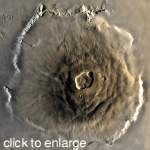 Mars has many striking surface features, such as Olympus Mons (right), a giant volcano, three times the height of Everest, with a base 600 km in diameter. An extensive valley complex, named Valles Marineris, can be followed for a total length of over 4,500 km, and, in places, descends to 7 km below the rim. Recently, a Smiley Face and a Heart-shaped feature have been imaged. Mars has many striking surface features, such as Olympus Mons (right), a giant volcano, three times the height of Everest, with a base 600 km in diameter. An extensive valley complex, named Valles Marineris, can be followed for a total length of over 4,500 km, and, in places, descends to 7 km below the rim. Recently, a Smiley Face and a Heart-shaped feature have been imaged.
Whispy Atmosphere
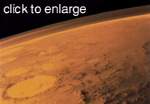 The martian atmosphere is mainly CO2 (95%), the rest being nitrogen and argon. The very low surface pressure, at around 10 mbar (200 Pa), is due to the lack of depth of atmosphere, as shown in the image (right). Most of its atmosphere was stripped away by the Sun's solar wind. Under these conditions, liquid water cannot exist on the surface. However there is plenty locked up in the polar caps, and probably underground. The martian atmosphere is mainly CO2 (95%), the rest being nitrogen and argon. The very low surface pressure, at around 10 mbar (200 Pa), is due to the lack of depth of atmosphere, as shown in the image (right). Most of its atmosphere was stripped away by the Sun's solar wind. Under these conditions, liquid water cannot exist on the surface. However there is plenty locked up in the polar caps, and probably underground.
Liquid Water on Surface?
Reportedly, liquid water has been discovered running on the surface of Mars in low canyons.
The possibility of water on Mars will spur us on to explore our
neighbouring world, on which life could once have started and may even still exist today. Read this BBC article.
Out in the Cold
Mars experiences a wide range of temperatures. Away from the equator, maximum daytime temperatures reach only -30°C, while, on the equator, this can rise to over 22°C. The thin atmosphere is a poor heat retainer, and night-time temperatures fall to around -100°C in even the warmest of places.
The wide range of temperatures are the cause of extremely high winds across the planet, producing fearsome dust storms which can be seen with telescopes from the Earth. Coupled with seasonal changes at the poles, the surface appearance is constantly changing.
 Twin Moons! Twin Moons!
Mars has two tiny, rapidly-orbiting moons: Phobos & Deimos. Learn more.
Writes Heather Couper...
 Together with Nigel Henbest, Britain's most famous female astronomer provide a full background on our nearest planetary neighbour. Everything you knew, or thought you knew, up until now is just peanuts compared to this! Together with Nigel Henbest, Britain's most famous female astronomer provide a full background on our nearest planetary neighbour. Everything you knew, or thought you knew, up until now is just peanuts compared to this!
Check out MARS today.
Top Right ^^
|
Mission: Mars!
Many missions by both the USA and Russia have been unsuccessful. However, some have survived the perils of inter-planetary travel, bringing us an enticing view of the planet. The first accurate information gained about the planet came from the American Mariner missions conducted during the 1960's and culminating in the Mariner 9 launch in 1971. Viking 1 and 2 were to land on the planet in 1976 and provided the first views from the planet's surface.
Viking Lander
Europe's Mars Express
 The Mars Express spacecraft launched on 2 June 2003 and arrived at Mars on Christmas Day. Phobos, the tiny innermost moon of Mars, is to come under detailed scrutiny. Mars Express will pass within 3000 km of the moon a few hundred times during its two-year mission. The mars lander on board was even more exciting... The Mars Express spacecraft launched on 2 June 2003 and arrived at Mars on Christmas Day. Phobos, the tiny innermost moon of Mars, is to come under detailed scrutiny. Mars Express will pass within 3000 km of the moon a few hundred times during its two-year mission. The mars lander on board was even more exciting...
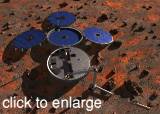 Britain's Back! Britain's Back!
With a mass of less than 30 kg, the Open University's Beagle 2 represented the most ambitious science payload to systems mass ratio ever attempted.
 Almost a third of the payload was designed to carry out various types of analysis or be used to manipulate and collect samples for study on the surface of Mars. Almost a third of the payload was designed to carry out various types of analysis or be used to manipulate and collect samples for study on the surface of Mars.
It left Mars Express successfully, but nothing more was heard from Beagle 2. It probably crash-landed. One day we will know its fate - as at January 2006 there is some evidence to suggest that it landed and deployed, but hit the ground too hard, damaging its communications facility.
[images: all rights reserved Beagle 2]
NASA: Success & Failures
On July 4th, 1997 NASA's Pathfinder mission landed "Sojourner", a roving vehicle. In the picture above, you can clearly see the vehicle on the landing platform, surrounded by the now-deflated air bags that cushioned its landing! In the picture below, Sojourner has set off to explore the Martian surface:
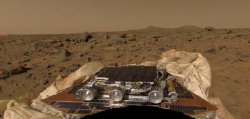
Sojourner Has Landed - click to enlarge
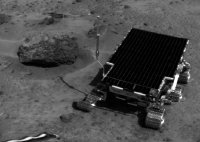
"Let's Rock!" - click to enlarge
In late 1997, Mars Global Surveyor arrived to map the surface in intricate detail. It has obtained a map of nearly all the surface in more detail than ever before.
In 1999, the Mars Climate Orbiter (MCO) passed too close to the planet on approach, and hit its atmosphere, exploding. More info. Only months later, the Mars Polar Lander (MPL), apparently landed at Mars' South Pole, but failed to send any signals back. More info.
Navigate:
Map of Mars | Mythical Icons

View/Sign Guestbook
|


